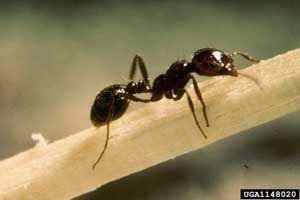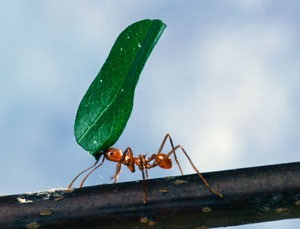Easy to distinguish by their size, carpenter ants are large in comparison to other species, up to 1/2 inch in length. Most species are dark colored, often black. Carpenter ants do not sting, but they have powerful jaws that can inflict a painful bite. They emit an unpleasant smell (formic acid) when disturbed.
(also called Cut Ants, Cutter Ants, Fungus Ants, Parasol Ants, Texas Leafcutting Ants, Town Ants)
These ants are rust colored with visibly large (wide) heads. The worker ants 1/10 to 1/2 inches long. Leafcutting ants live in large colonies that consist of crescent-shaped mounds on above ground and extensive underground chambers. The mounds may be contained within a small area or cover several acres. Foraging trails devoid of vegetation are usually found near the mounds.
Adult fire ants look like many other ants. They are reddish to dark brown in color and worker ants are from 1/8 to 1/4 inch long. The females are about 1/3 of an inch long. There are also winged males and queens. Mounds can vary in size and shape, but usually the larger the mound the larger the colony.
Carpenter ants bore into wood to make their nests. This complex network of tunnels and chambers usually starts in an area of soft decay. Indoor carpenter ant nests are bored into the wooden parts of the building, sometimes causing serious structural Damage. They may also nest in walls, hollow doors, cracks and crevices, furniture, and empty termite galleries. New buildings can become infested when land clearing disturbs existing nests.
These ants attack hundreds of trees, shrubs and ornamental plants by stripping off the leaves, flower buds, and stems. They don't actually eat the leaves, but use them as a food substrate for the fungus that ants grow and feed on back at the nest. Usually found in the southern U.S., these ants are capable of destroying large numbers of pine seedlings by removing the needles, buds, and bark during months when other green vegetation is scarce or unavailable. Leafcutting ants can also inflict a painful bite when disturbed.
When their nests are disturbed, these ants inflict painful stings on humans by clamping down with their powerful jaws and attacking repeatedly. With each sting they inject venom that creates a burning sensation. The stings cause itching blisters that may become infected and leave scars. Certain people may have severe allergic reactions to their stings (including death from anaphylactic shock). Fire ants cause minor injuries to livestock. Their mounds can be unsightly in the landscape and may cause minor Damage to farm equipment working in fields. Fire ants were accidentally imported to the U.S. from South America. They are currently found in 14 southern states and appear to be expanding northward.

About The Author: Ellen Brown is an environmental writer and photographer and the owner of Sustainable Media, an environmental media company that specializes in helping businesses and organizations promote eco-friendly products and services. Contact her on the web at http://www.sustainable-media.com
Add your voice! Click below to comment. ThriftyFun is powered by your wisdom!
Thanks for the Ant Tip. I'll try the Epsom Salts Tip
I use Fire Ant bait, but it's costly. There bite is really painful and itchy, they are really bad on kids playing and running across the mounds
Sherry
I have an ant nest under my strawberry plants. I assume I can't use epsom salts in this case. What's the best option?
Add your voice! Click below to comment. ThriftyFun is powered by your wisdom!